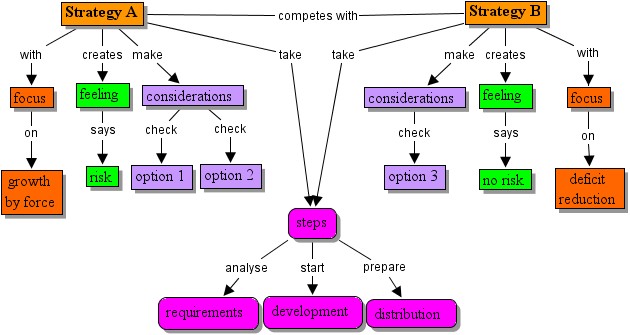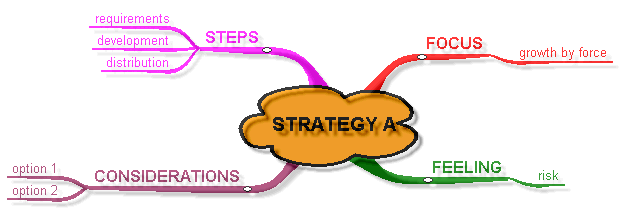Maps of the mind
Volker Rautenberg
26 Jan 2004 (last change: 30 Mar 2017)
Abstract
This article provides a short introduction to the mapping of the mind. The most popular types of maps are concept maps and mind maps® which are considered and evaluated here.
Introduction
It was some years ago that I saw my first mind map, it was a hand-drawing done with a simple black pencil. I was curious to learn more about this unusual way of ‘writing’ and in particular I was interested in computer-based mind mapping. So I went into a book store and found what I was looking for: a book about computer mind mapping (Kommer+Reinke2001) which also discussed a lot of other creativity and mind techniques as well as related software. Since then MindManager® 4.0 from Mindjet® is my favourite mind mapping software, though I also use FreeMind on a regular basis.
However, in the course of my concern with this mind matter it turned out , that I had to learn that there is not only one approach to the mind and its mapping…
Maps of the mind
Right, this is maps of the mind. I came across this term in a PhD thesis of Paul C Schroeder (Schroeder2003); he defines maps of the mind as follows:
…maps of the mind are attempts to graphically illustrate mental and linguistic processes and other factors that make up the mind.
This definition includes two prominent representatives of maps of the mind that are briefly introduced in the following sub-sections:
- Concept maps,
- Mind maps®
Concept maps
Concept maps are around since the 1960s. Here is the definition of concept maps given by Novak and Cañas (Novak+Cañas2006):
Concept maps are graphical tools for organizing and representing knowledge. They include concepts, usually enclosed in circles or boxes of some type, and relationships between concepts indicated by a connecting line linking two concepts. Words on the line, referred to as linking words or linking phrases, specify the relationship between the two concepts. We define concept as a perceived regularity in events or objects, or records of events or objects, designated by a label. The label for most concepts is a word, although sometimes we use symbols such as + or %, and sometimes more than one word is used. Propositions are statements about some object or event in the universe, either naturally occurring or constructed. Propositions contain two or more concepts connected using linking words or phrases to form a meaningful statement.
The basic structure of a concept map is that of a network. A sample concept map is shown here:

Mind maps®
Mind maps have been invented by Tony Buzan in the late 1960s; he published the mind mapping method in 1974. So, mind maps are a bit younger than concept maps. Mind map® is a registered trademark of the Buzan Centres Ltd. The definition of mind maps is much simpler than that of concept maps. I recommend to click here and also look at how to mind map. Both links direct you to the Buzan Centres Ltd.
The essential elements of a mind map include the following items:
- A mind map has a central word or image.
- From the centre, branches are growing into all directions.
- The branches carry words, images or symbols which are neatly drawn along the branches.
- Intensive use of colours.
- Please and stimulate your brain in manifold ways.
The basic structure of a mind map® is that of a tree. I have created a sample mind map which shows the ‘Strategy A’ of the above concept map:

Note, that there is a principal difference between mind maps and concept maps: that between a tree and a network structure. A mind map always has a central idea while a concept map may have many. As a consequence the above concept map may not equivalently be drawn as a mind map.
There is a nice article about mind mapping written by Christoph Rissner (Rissner2003). He gives an overview of the mapping’s roots and backgrounds. A definitive must-read is Tony and Barry Buzan’s (2001, 2002) mind map book Buzan+Buzan2002. I simply find it a pleasure…
Some notes on both approaches
The following table reflects my personal impressions and thoughts on concept and mind maps:
| Aspect | Concept maps | Mind maps |
|---|---|---|
| Academic impact | Higher: There are many scientific papers showing a pronounced interest in concept maps. | Lower: I have hardly found a scientific paper about mind maps. |
| Semantic richness | Higher: Links carry additional information mostly as short verbal phrases. | Lower: Branches preferably carry single or few words, mostly nouns. |
| Formality | Higher | Lower |
| Aesthetics | Lower. Look like tecnical diagrams. | Higher: Good mind maps look like artwork. |
| Brain adequacy | Lower | Higher |
| Ease of creation | Lower | Higher |
Software for the mapping of the mind
This section offers a tabular overview of software that supports mapping of the mind. Note, that the table does not claim to be complete.
| Product | Supported map types | Remarks |
|---|---|---|
| Axon Idea Processor | Concept maps, mind maps and many others | Three-dimenional maps are possible, commercial license |
| FreeMind | Mind mapping | Free software, GNU General Public License |
| CmapTools | Concept mapping | Registration required, no cost, closed source |
| iMindMap™ | Mind maps | Commercial license impressive look and feel of maps |
| Mind Manager® | Mind maps | Commercial license, established product |
| TheBrain | Network-like maps | Commercial license |
| XMind | Mind maps and others | Commercial license, no-cost edition available |
A comprehensive overview of mind mapping software is available here.
Bibliography
- Buzan+Buzan2001
Buzan, Tony and Buzan, Barry (2001). The Mind Map Book. BBC Consumer Publishing. ISBN 0563537329.
- Buzan+Buzan2001
Buzan, Tony and Buzan, Barry (2002). Das Mind-Map Buch. 5., aktualisierte Auflage. mvg Verlag, Landsberg, München. ISBN 3478717310. (In German).
- Kommer+Reinke2001
Kommer, Isolde and Reinke, Helmut (2001). Mind Mapping am PC. 2. Auflage. Carl Hanser Verlag, München. ISBN 3446216510. (In German).
- Novak+Cañas2006
Novak, Joseph D and Cañas, Alberto J (2006). The theory underlying concept maps and how to construct them. Technical Report IHMC CmapTools 2006-01. Florida Institute for Human and Machine Cognition. PDF download.
- Rissner2003
Rissner, Christoph (2003). Seminarwork mind maps. URL no longer valid: http://courses.iicm.edu/~hkrott/site/docs/seminar/sem2002_mindmaps.pdf.
- Schroeder2003
Schroeder, Paul Charles (2003). Spatial aspects of metaphors for information: implications for polycentric system design. PhD thesis at the University of Maine. URL no longer valid: http://www.spatial.maine.edu/~schroedr/thesis/pcsthesis20030828.pdf.
Copyright © 2007, 2017 by Volker Rautenberg. Some rights reserved.
Except where otherwise noted, this work is licenced to the public under a Creative Commons Attribution-NonCommercial-NoDerivatives 4.0 International License.
The names of companies and products mentioned in this work may be trademarks, registered trademarks or service marks of their respective owners. Trademarks and service marks are used for referential purposes only and are not intended to infringe the rights of the mark owners.
